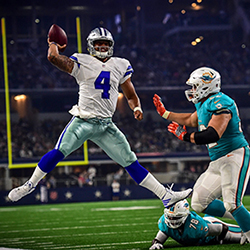Offense
Majority of people look at the quarterback as the leader of the team. The most high profiled position on the field, along with being the most important position on the team. A good quarterback is known for his outstanding throws, but what most people don’t know is the physics that make up his throws. While the football is moving through the air with a constant velocity, there will be air resistance which will make the football decelerate causing a projectile motion. The football will continue to move in uniform motion until the offensive player catches the ball.
When making a glorious throw to an offensive player down field, the quarterback needs to have a tight spiral on the ball. When the football is being thrown it possess an angular momentum. [1] If this is done than the angular momentum of the football is conserved along its trajectory, then the axis of the ball should keep a constant orientation with respect to the ground.
One might ask, “Does the angular momentum of the football change through the flight?” Yes, the angular momentum changes in a result of a torque. Aerodynamic drag is acting upon the football around its center mass.
The force of the air pressure on the leading surface of the football can be resolved into single force acting at a point known as the center pressure[1]. You may wonder if this is true when the quarterback throws a duck pass. Duck pass is known as a wobbly football with a spiral, making it look like a duck in flight. At this time a torque free precession is formed. This occurs when the football is given multiple spins on the axis of rotation and the transverse axis.
When the quarterback hands the ball off to the running back, it is now the running backs show. A great example would be the NFL leading rusher Zeke (Ezekiel Elliott), with his agility and powerful running he always is able to memorize the crowd. When Zeke is carrying the ball he is running with acceleration while picking up momentum. When a would be tackler meets Zeke it must apply impulse in the opposite direction. At this moment there are two different scenarios that can occur.
Scenario #1
When the tackler collides with Zeke and doesn’t bring him to a stop it is considered an elastic collision. This occurs when Elliott has more momentum then the defender, and breaks the tackle and accelerates again.
Scenario #2
When defenders hold on to Zeke and they both travel together there forces combine as one. This is known as inelastic collisions, where the speed is due to the fact that the difference in momentum is now distributed over the combined mass of the players, instead of the mass of the one player with less momentum. [3]






